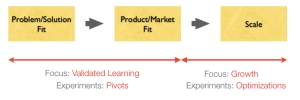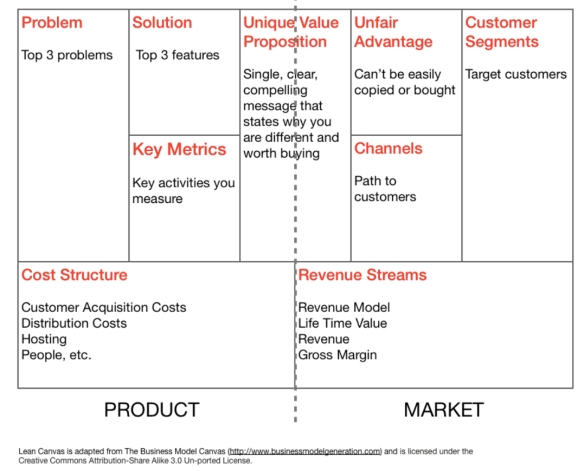Running Lean (e-book) attacks the problem of how to grow web start-ups. Ash Maurya has taken my favourite business model tool “The Business Model Generation” and tweaked it to meet his need of web SaaS companies. For me this book was almost two books in one, peppered with some great tips on going companies:
 1) A variant on the business model generation for SaaS companies– the Lean Canvas
1) A variant on the business model generation for SaaS companies– the Lean Canvas
2) A form of the agile development process, adapted to web companies, integrating agile development, experience design and market validation.
The “lean canvas” section was of most interest to me and I finished feeling I wanted more,“perhaps the sign of a great book” – but worth the $19.95 all the same.
The Lean Canvas:
The lean canvas is an adaption of Alex Osterwalder’s “Business Model Canvas” which he describes in his book: “Business Model Generation”. For those who are not aware of this methodology I would strongly suggest a read of my book review.
Ash dropped – partners, key activities, key resources and customer relationships and replaced them with Problem, Solution, Key Metrics and Unfair Advantage.
I empathise with the Steve Blank’s quote:
“Business Plan: a document investors make you write, that they don’t read”.
My advice to entrepreneurs is use a business model canvas to bait discussion and debate. Hell you may not even need as business plan.
One of the key advantages of this sort of technique is that can create several business models in one afternoon rather than taking months to perfect a business plan that is out of date. Ash recommends doing one canvas per customer segment.
I am a great fan of the business model canvas tool to speed up decision-making and the communication of business plans for both investors and staff.
Of the modifications made to the original plan – I most like the focus on “unfair advantage” and will add this into my own variant inspired by this technique.
An example of the tips that Ash has on start-ups:
- If you’re going to charge for a SaaS do so from day one – Price is a key ingredient to your product test it early – if you need a new business model find out early.
- There is an “I” on Vision – create a business model in isolation but then test it and test it.
- Plan A’s never work – so be ready to adapt and create plan B and C quick.
- Focus on activities that generate results – don’t get distracted on long-term activities as many will become redundant as you adapt
- Distinguish between users and customers – always splinter customers into smaller subgroups
- 3 must have departments Design, Development and Marketing – all of equal importance
- Getting investor funding is NOT market validation
- Have staff meeting’s in most unproductive part of day – not first thing.
Development Model:
Ash’s development model is based around three iterative stages:
1) Problem/Solution Fit : Do I have a problem worth solving?
- Is it a must have – if you take the solution away will they mind
- Can it be solved – feasible
- Will they pay for it? If not who will?
2) Product/ Market Fit : Have I built something people want?
3) Scale: How do I accelerate growth
 The book devotes the majority of its 200 odd pages to describing this model-process in detail.
The book devotes the majority of its 200 odd pages to describing this model-process in detail.
Close, constant and controlled customer feedback is the main theme around which he builds his model to develop the product/service around similar minimum viable product (MVP) principle the 37Signals team describe in Rework. (read my review here)
If you are interested in using diagrams and visual models to speed up your business planning and improve your stakeholder communication I would suggest coming along to one of my business planning seminars .
Oh – yes have a read of this e-book along with “the business model generation” and also check out Ash’s Blog


Glad you enjoyed it!
Jason Armishaw
Good post, amongst a lot of good posts.
keep it going!
Hey Mark! Can I get your feedback on the SaaS business model canvas?
Love to, went to your http://www.saascanvas.com/ web site and there did not appear to be a button to view it – send me a copy mark@sparkventures.com
Check out my updated version of the canvas https://succinctstories.wordpress.com/2012/10/18/gmc-business-model-canvas-v2/
whoah this blog is excellent i really like reading your articles.
Keep up the good work! You recognize, a lot of individuals are hunting round for this info, you can help them greatly.
Hi Mark,
would be great to get your views on this: https://medium.com/@asimmehr/the-people-canvas-67902bc02a46
Pingback: What is a Lean Canvas and Why it's a must have for Every Startup
Pingback: An Introduction to Lean Model Canvas by Steve Mullen | Startup Anambra | Official Website
Pingback: Lean Canvas: Pengertian, Sejarah, Fungsi, Contoh dan Komponennya - ABC Semanggi - Aplikasi pembukuan paling TOP di indonesia
Pingback: An Simple Introduction to Lean Canvas Modelling Tool
Pingback: Digital Marketing Foundations – Marketing Through Social Media